Retail organizations face increasing difficulty in stopping ransomware attacks, with only 26% of consumer outfits this past year able to disrupt a cyber hijacking before their data was encrypted.
According to Sophos’ State of Ransomware in Retail 2023, the figure is a three-year low for the sector, a decline from 34% in 2021 and 28% in 2022.
"Retailers are losing ground in the battle against ransomware," said Chester Wisniewski, Sophos’ director and global field chief technology officer. "Ransomware criminals have been encrypting increasingly greater percentages of their retail victims in the last three years, as evidenced by the steadily declining rate of retailers stopping cybercriminal attacks in progress. Retailers must up their defensive game by setting up security that detects and responds to intrusions earlier in the attack chain.”
The survey polled 3,000 IT/cybersecurity leaders in organizations with between 100 and 5,000 employees, including 355 from the retail sector, across 14 countries in the Americas, EMEA and Asia Pacific.
Retail Industry is Top Attack Target
Additional key findings from the report include:
- The retail sector experienced its highest rate of encryption over the past three years, with 71% of those organizations targeted by ransomware stating that attackers successfully encrypted their data.
- The percentage of retail organizations attacked by ransomware declined from 77% last year to 69% this year.
- The percentage of retail organizations that recovered in less than a day decreased from 15% to 9% this year, while the percentage of retail organizations that took more than a month to recover increased from 17% to 21%.
- Organizations that met the cyber kidnappers’ demands were four times the recovery costs of those that used backups to recover their data ($3,000,000 versus $750,000).
“Forty-three percent of retail victims paid the ransom according to our survey respondents, yet the median recovery cost to victims who paid the ransom was four times the cost to those who used backups and other recovery methods,” said Wisniewski. “There are no shortcuts in these situations and rebuilding systems is almost always required. It's better to deprive the criminals of their spoils and build back better.”
Sophos: Shields Up
Sophos recommends the following best practices to strengthen defensive shields.
- Use security tools that defend against the most common attack vectors, including endpoint protection with strong anti-ransomware and anti-exploit capabilities.
- Implement Zero Trust Network Access (ZTNA) to thwart the abuse of compromised credentials.
- Adaptive technologies that respond automatically to attacks disrupt adversaries and buy defenders time to respond.
- Deploy 24/7 threat detection, investigation and response, whether delivered in-house or by a specialized Managed Detection and Response (MDR) provider.
- Improve attack preparation, including regularly backing up, practicing recovering data from backups and maintaining an up-to-date incident response plan.
- Maintain security hygiene, including timely patching and regularly reviewing security tool configurations.




